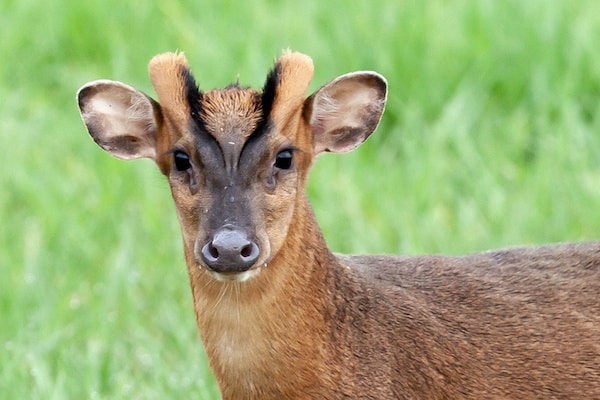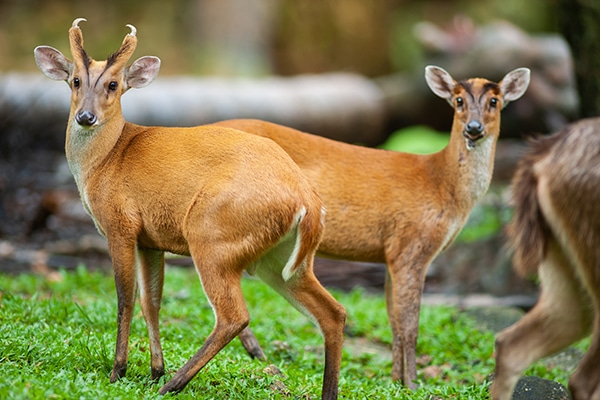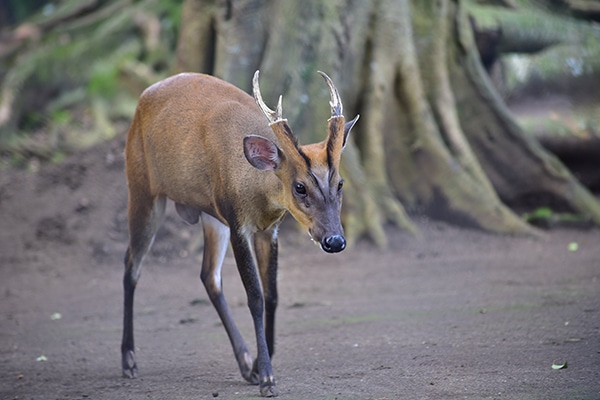MUNTJAC DEER: EVERYTHING YOU NEED TO KNOW ABOUT THE MYSTERIOUS “ALIEN DEER”
MUNTJAC DEER FACTS
Muntjac deer were first introduced to the United States in the 1900s and are often considered invasive. Their distinctive physical characteristics set them apart from other deer species as they look like aliens. These include:
- Short, stocky build: Muntjac deer have a compact, muscular body with short legs that give them a low profile of about two feet tall, which makes them agile and quick.
- Antlers: Male Muntjac deer grow small, curved antlers that are shed and regrown annually. The antlers are relatively short and simple, with only one or two points.
- Canine teeth: Both male and female Muntjac deer have long, protruding canine teeth that are used for territorial displays and self-defense. These teeth are unusual for deer and give Muntjac deer a distinctive appearance.
- Red-brown coat: Muntjac deer have a reddish-brown coat that is speckled with white spots in some subspecies. The coat is soft and thick, providing insulation in cold weather.
- Large, expressive eyes: Muntjac deer have large, dark eyes that are set high on their head. This gives them a wide field of vision and helps them detect potential predators or threats.
Overall, these physical characteristics make Muntjac deer unique and easily recognizable, even from a distance.

MUNTJAC DEER FACE
The face of a muntjac deer is a study of delicate beauty. With their large, expressive eyes and small, pointed ears, these deer have a charming and endearing appearance. Their faces are framed by a short, dark muzzle, which houses their long canine teeth. These teeth are a distinctive feature of the muntjac deer and are used for both defense and territorial displays. Additionally, the fur on a muntjac deer’s face is soft and velvety, providing a tactile contrast to the hard bone structure of their skull. Whether in the wild or captivity, the gentle and curious expression of a muntjac deer’s face will surely captivate all who see it.
MUNTJAC DEER SCENT GLANDS
The Muntjac have two types of glands on their face: frontal scent and preorbital glands. They are the only deer with frontal glands; others have preorbital glands. The frontal glands, which form a “V” shape with the horns, are used for marking territory.

ARE THERE MUNTJAC DEER IN THE UNITED STATES?
Yes, there are populations of Muntjac deer in the United States. However, they are not native to the country and are considered invasive in some areas. Muntjac deer were first introduced to the U.S. in the 1900s for use as game animals on private hunting preserves. Since then, some Muntjac deer have escaped from these preserves or been illegally released into the wild, leading to established populations in several states, including Texas, Virginia, and Mississippi. The presence of Muntjac deer in the U.S. has raised concerns about their potential impact on native wildlife and ecosystems, as well as the risk of disease transmission to domestic livestock. Efforts are underway to control and manage these populations to minimize their negative impacts.
DO MUNTJAC DEER MAKE GOOD PETS?
Muntjac deer do not make good pets. While they may appear cute and docile, they are wild animals and have specific needs that are difficult to meet in a domestic setting. Muntjac deer are known for being very active and curious, and they require a large, secure outdoor space to roam and explore. They are also social animals and do best in groups, which can be difficult to achieve in a home environment. Additionally, Muntjac deer are not domesticated and can exhibit unpredictable behaviors that may be dangerous for their owners and others around them. It is also important to note that owning Muntjac deer as pets in many countries, including the United States, is illegal without proper permits and licenses. For these reasons, it is best to admire Muntjac deer from a distance in their natural habitat or in zoos and wildlife parks.
WHY DOES THE MUNTAC DEER FACE MOVE?
The movements of a Muntjac deer’s face are largely related to its sense of hearing and its need to be aware of its surroundings. Muntjac deer have a highly developed sense of hearing and use their ears to detect sounds from predators or other potential threats. The muscles in their face, particularly around the ears, allow them to move their ears in different directions to better pinpoint the location of sounds. Additionally, Muntjac deer are social animals and use facial expressions to communicate with one another. They can use various facial expressions, such as tilting their head, raising their ears, and widening their eyes, to signal their emotional state or intentions to other deer. Overall, the movements of a Muntjac deer’s face serve important functions in helping them navigate their environment and interact with others in their social group.

WHY DO MUNTJAC DEER SCREAM
Muntjac deer produce a high-pitched scream, often described as sounding like a barking dog or a crying baby. They may scream for various reasons, including as a warning signal to other deer in their social group about the presence of a potential predator or to attract a mate during the breeding season. Additionally, Muntjac deer may scream when they are injured or distressed, such as when they are caught in a trap or are being hunted. The loud, piercing sound of a Muntjac deer’s scream is a natural defense mechanism that can startle or deter potential threats and help them to avoid danger. Overall, the screaming behavior of Muntjac deer is an important aspect of their communication and survival strategies in the wild.
DO PEOPLE EAT MUNTJAC DEER?
Yes, Muntjac deer are hunted and consumed as food in some parts of the world, particularly in their native range in South and Southeast Asia. Muntjac deer meat is considered a delicacy in some cultures and is known for its tenderness and distinctive flavor. However, hunting and consuming them is not common or widely accepted in many countries where Muntjac deer have been introduced, such as the United Kingdom and the United States. In fact, in some areas, Muntjac deer are considered an invasive species and are actively managed or culled to prevent damage to crops and ecosystems. Additionally, it is important to note that hunting and consuming wild animals can have potential health risks, and it is essential to follow proper food safety guidelines and regulations to ensure the safety of both the animal and the consumer.
Follow Useless Knowledge on Instagram for more amazing facts.
If you enjoyed this Useless Knowledge post, you should check out Baby Pigeons: Why don’t we see them? for a fascinating look at baby pigeons.